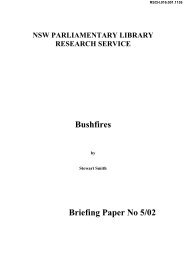the february 2009 fires - 2009 Victorian Bushfires Royal Commission
the february 2009 fires - 2009 Victorian Bushfires Royal Commission
the february 2009 fires - 2009 Victorian Bushfires Royal Commission
You also want an ePaper? Increase the reach of your titles
YUMPU automatically turns print PDFs into web optimized ePapers that Google loves.
<strong>2009</strong> <strong>Victorian</strong> Bush<strong>fires</strong> <strong>Royal</strong> <strong>Commission</strong>—Interim Report<br />
1 THE FEBRUARY <strong>2009</strong> FIRES<br />
1.127 Marysville was most affected by this fire, with a resident population of 517. The area surrounding Marysville<br />
has a population of 1200 people. 328<br />
1.128 Just before 15:00 a fire at Murrindindi Mill was reported to <strong>the</strong> Broadford and Alexandra DSE offices from<br />
<strong>the</strong> Mount Despair fire lookout tower. 329 The point of origin was estimated to be 2 kilometres south of<br />
Murrindindi on private land within <strong>the</strong> fire protected area, 330 and while this was not clear in <strong>the</strong> early stages of<br />
<strong>the</strong> fire, DSE became <strong>the</strong> control agency for this fire. 331 Fire control was through a DSE ICC at Alexandra. 332<br />
DSE had already deployed IMT personnel from Alexandra to support <strong>the</strong> CFA IMT managing <strong>the</strong> Kilmore<br />
East fire. 333 This included information and situation officers. Because of this, DSE advised that <strong>the</strong> Alexandra<br />
IMT was initially under-resourced. 334<br />
335<br />
1.129 CFA resources were deployed from <strong>the</strong> Yea Group and were <strong>the</strong> first to arrive at <strong>the</strong> fire. All local DSE<br />
fire line resources that had not been deployed to <strong>the</strong> Kilmore East fire (which was reported at 11:49), were<br />
deployed to <strong>the</strong> Murrindindi fire (being crews from Toolangi, Alexandra and Broadford). 336 The Toolangi DSE<br />
crew is recorded as responding at 15:00, with an estimated time of arrival of 15:30, although <strong>the</strong> first DSE<br />
resources were recorded as arriving at <strong>the</strong> fire at around 16:15. 337 Care was taken not to direct crews to<br />
take roads that might be affected by this fire, with <strong>the</strong> Alexandra crew taking a circuitous route. This initial<br />
attack on <strong>the</strong> fire included 6 personnel, 1 tanker, 2 slip-on units and 1 ‘first attack’ dozer. 338<br />
1.130 Early observations reported by <strong>the</strong> IMT were of severe fire behaviour, with flames 20 metres high and an<br />
estimated rate of spread of 8 kilometres per hour. Spotting was estimated at 5 kilometres. 339 Post-fire<br />
analysis indicated this was under-estimated — <strong>the</strong> likely spread of <strong>the</strong> fire was around 12 kilometres per<br />
hour with spotting to 15 kilometres. 340 The Alexandra DSE Office estimated a rate of spread of 8 kilometres<br />
per hour earlier in <strong>the</strong> day, based on <strong>the</strong> wea<strong>the</strong>r forecast. This was twice <strong>the</strong> speed of fire spread normally<br />
experienced in forest fire. 341<br />
1.131 The severity of <strong>the</strong> fire behaviour precluded direct attack, and both DSE and CFA resources concentrated<br />
on community and asset protection. Aerial support was sought to manage fire spread. 342<br />
1.132 The fire spread rapidly into <strong>the</strong> forests of <strong>the</strong> Black Range, between <strong>the</strong> Melba and Maroondah Highways,<br />
and began spotting when it reached <strong>the</strong> top of <strong>the</strong> range. In fact, <strong>the</strong> fire was burning in forest 3 kilometres<br />
from its point of origin, until it reached <strong>the</strong> outskirts of Narbethong, a fur<strong>the</strong>r 17 kilometres away. Additional<br />
response resources were mobilised. 343 The Mount Gordon tower observer reported that at 16:20 <strong>the</strong> fire<br />
was crossing <strong>the</strong> Black Range. 344 The tower was abandoned at 16:30. 345<br />
346<br />
1.133 Two water-bombing aircraft and 1 light helicopter left Mansfield, arriving at <strong>the</strong> fire around 15:45. Water<br />
bombing was ineffective, due to <strong>the</strong> wea<strong>the</strong>r conditions, and each aircraft only made one bombing run. 347<br />
Additional dozers and graders were deployed from DSE and Murrindindi Shire for control line construction.<br />
DSE ground crews were deployed to communities to <strong>the</strong> east and west of <strong>the</strong> Black Range. 348<br />
1.134 The fire moved across <strong>the</strong> Black Range very quickly and was spotting long distances. At 16:30 spot <strong>fires</strong><br />
and ember attack were reported in <strong>the</strong> Narbethong area, and aircraft were forced to suspend operations<br />
due to <strong>the</strong> increasingly hazardous flying conditions. 349 The Bushfire CRC Report indicates fire spread was<br />
likely to have been <strong>the</strong> result of ‘substantial spotting’. 350<br />
1.135 Fire crews were hampered by new <strong>fires</strong> created by spotting; <strong>the</strong>se were moving towards <strong>the</strong> Marysville area.<br />
Firefighters continued to work on asset protection under extremely difficult conditions. A back burn was<br />
attempted around 18:00 east of Marysville, although it was quickly abandoned ‘when it became hazardous<br />
and was going to be overrun by <strong>the</strong> main fire’. 351<br />
1.136 After 18:30 <strong>the</strong> south-westerly wind change arrived. Advice from DSE indicates <strong>the</strong> wind change arrived<br />
earlier and passed through <strong>the</strong> area with greater force than forecast. 352 The wind continued to change<br />
direction during this period, making it difficult to identify <strong>the</strong> direction of spotting and firefront movement. 353<br />
Lightning from intense smoke plumes and atmospheric interaction with <strong>the</strong> south-west change triggered<br />
o<strong>the</strong>r <strong>fires</strong> between <strong>the</strong> Murrindindi and Bunyip <strong>fires</strong>. 354<br />
70
















